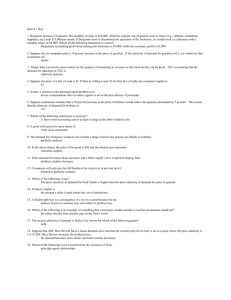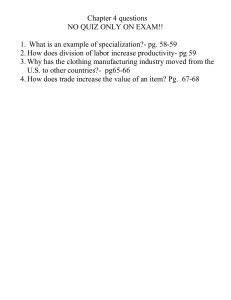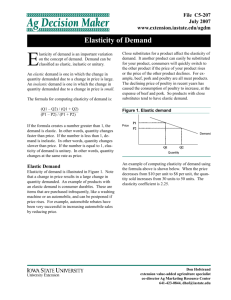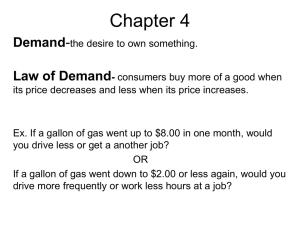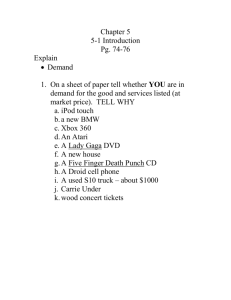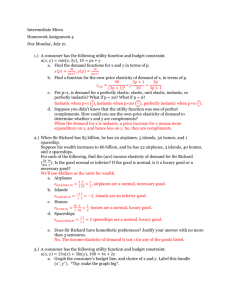INTRODUCTION Engineering Economics: Decision
advertisement
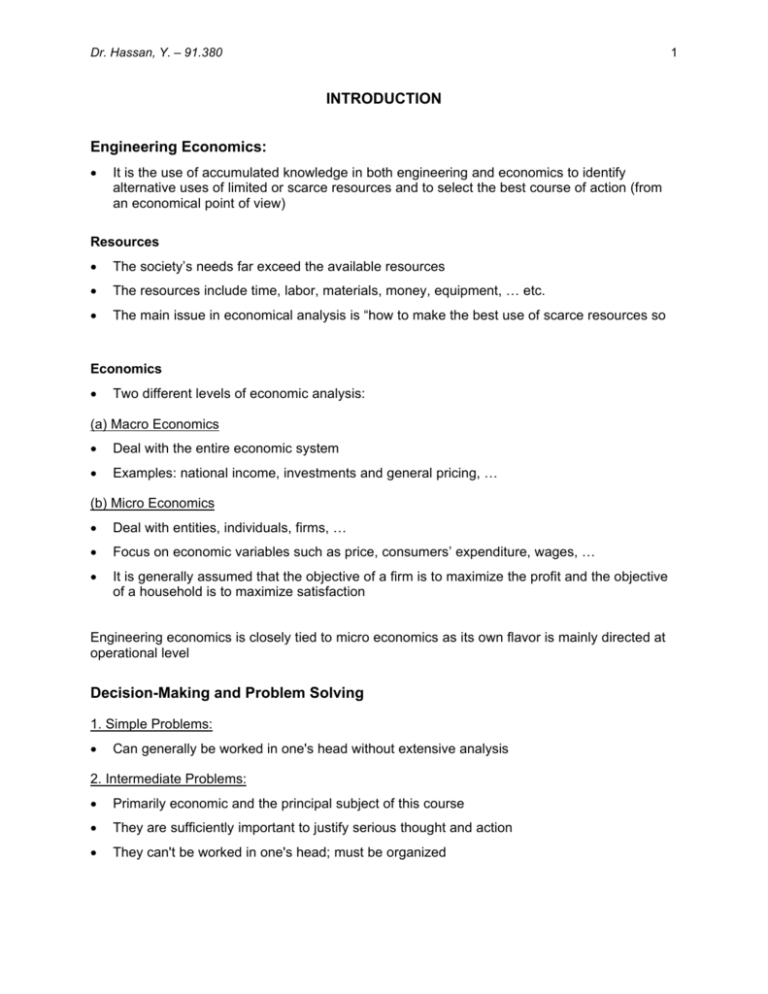
Dr. Hassan, Y. – 91.380 1 INTRODUCTION Engineering Economics: • It is the use of accumulated knowledge in both engineering and economics to identify alternative uses of limited or scarce resources and to select the best course of action (from an economical point of view) Resources • The society’s needs far exceed the available resources • The resources include time, labor, materials, money, equipment, … etc. • The main issue in economical analysis is “how to make the best use of scarce resources so Economics • Two different levels of economic analysis: (a) Macro Economics • Deal with the entire economic system • Examples: national income, investments and general pricing, … (b) Micro Economics • Deal with entities, individuals, firms, … • Focus on economic variables such as price, consumers’ expenditure, wages, … • It is generally assumed that the objective of a firm is to maximize the profit and the objective of a household is to maximize satisfaction Engineering economics is closely tied to micro economics as its own flavor is mainly directed at operational level Decision-Making and Problem Solving 1. Simple Problems: • Can generally be worked in one's head without extensive analysis 2. Intermediate Problems: • Primarily economic and the principal subject of this course • They are sufficiently important to justify serious thought and action • They can't be worked in one's head; must be organized Dr. Hassan, Y. – 91.380 2 3. Complex Problems: • Such problems represent a mixture of economic, political and humanistic elements The Process of Problem Solving • Problem confined and clarified by “data” from the real world • Analysis of possible solution is done by “hypotheses” and economic models 1. Identifying the problem: - What went wrong? - What needs improvement? - What is not acceptable? 2. Defining the scope of the problem: - What is the cause of the economic problem? - What are the circumstances in which they occur? - What are the impacts of these problems? 3. Formulation of hypothesis: - A hypothesis is formulated about the relationships between different variables. (Cause and effect relationship) - Ads vs. demand, price vs. demand are examples of relationships between variables - Assumptions and abstraction of the real world are the key variables in the formulation of the hypothesis 4. Deduction of predictions: - Logical analysis and deduction of the hypothesis is done to find predictions for the solution as accurate as possible 5. Testing the accuracy of predictions: - This can be done by one or all of the following: - Compare to previous data - Refer to previous research studies - New data from questionnaires and interviews 6. Evaluation of results: - The predictions are confirmed by real world events - If the hypothesis is accepted, it becomes a theory What is an economic model? • It is expressing the relationships between variables in a mathematical form and using the real world data to measure the accuracy of predictions. Dr. Hassan, Y. – 91.380 3 Tactics and Strategy: • A strategic decision selects the overall plan that makes the best use of the organization’s resources in accordance with its long-term objectives • Tactics are the measures taken to implement a strategic decision. The “effectiveness” of each strategy is initially estimated from the efficiency of its tactics Sensitivity and Suboptimization: • A sensitivity analysis is done on any problem to examine the effect of deviation from the original problem condition • An insensitive situation occurs when all the tactics of a given strategy are more efficient than the best tactic of any other strategy • Suboptimization is choosing the course of action that would give the best results for multiple objectives, as the optimization of all objectives simultaneously is almost impossible Perspectives that lead to suboptimization: 1. Cross eyed view: - Focusing on one parameter while blurring other parameters may be very dangerous. 2. Shortsightedness: - Tactics based on short term planning horizons (1 or 2 years) may not have the same efficiency as those based on longer span of years. 3. Tunnel vision: - In a certain organization, all departments understand the common goals but individually may work that out in a way that hurts each other Example: The reduction of material and inventory cost is seen in different departments in different ways: - Purchasing: buy large quantities to get discounts - Comptroller: buy smaller quantities to avoid paying capital interest for capital required for purchasing - Production: Large inventories allow large production runs which reduce manufacturing costs - Warehousing: Large inventories cost more to store A Workable plan is a plan that “suboptimizes” the goals of each department Supply and Demand Demand: • Consumer’s behavior and the formation of the consumer’s demand is based mainly on psychological factors • “Rational People will always seek to maximize pleasure (they want satisfying power of Dr. Hassan, Y. – 91.380 4 commodities) and minimize pain in choosing between alternatives (convenience)” Variables that influence market demand: - Price - Consumer’s taste and preference - Consumer’s income and purchasing power: the higher the income, the higher the demand on products and services - Prices of relating items: eg. when the price of power increases (electricity) the demand for air conditioners decreases - Expectation of future prices (buy more quantities if the prices are expected to rise) - Range of variable products - Number of consumers and size of market Relationship between Price and Demand: P D (Demand) P D1 D Q Q • As the prices increase the demand decreases, which is logical as higher prices discourage sales • A decrease in demand (from curve D to D1) can have one or all of the following reasons: - Consumer’s taste switched to a competing product - Consumer switched to a less expensive substitute - The number of possible consumers decreased: eg., declining birthrates affect the market for prepared baby food - Expectation of lower prices in the future - Decline of buyer’s income decreases demand on goods (but this may increase the demand on inferior goods) Supply: • It is the amount of a particular product that the producers are willing to make available for consumers Factors that affect supply: - Prices of raw materials: an increase in the prices of raw materials of a certain product may raise price of the final product Dr. Hassan, Y. – 91.380 5 - Expectation of higher future prices: This may cause producers to immediately increase the supply - Firms leaving the market decrease the supply - Government policy such as taxes and subsidies Relationship between Supply and Price: P S (Supply) Q • Higher prices encourage greater production when all “other things” are equal • The other factors are usually non-price determinants Equilibrium of supply and Demand: P D S Surplus P2 Pe E (Equilibrium Point) P1 Shortage Q • The point of intersection of the two curves of the supply and demand represents the point of equilibrium (E) • E represents the point where a price is agreed upon between the consumers and the procedures “the price at which an amount of goods is willingly supplied and demanded (Pe)” • At a price less than Pe (P1) the quantity of the demand is more than the supply; thus, a shortage happens. The consumers will derive the price up by their willingness to pay more than P1 until Pe is reached • At a price more than Pe (P2) the quantity of demand is less than supply; thus, a surplus will happen. The suppliers will rationally decrease their price to sell the surplus until Pe is reached Dr. Hassan, Y. – 91.380 6 Elasticity of Supply and Demand: Elasticity of Demand: • Elasticity of demand measures the magnitude of the responsiveness or the sensitivity of the quantity demanded of a product to a change of price • Three things can happen to the total expenditure (P * Q) along the demand curve: • - Demand is inelastic: the total expenditure falls when the price falls, i.e. the quantity demanded (Q) is not changed by the change in price - Demand is elastic: The increase in price causes a decrease in total expenditure - Demand is unitary elastic: In this case a change in P causes a change in Q but in all cases the total expenditure (P * Q) is constant Most demand curves have the three types of elasticity consumers are unresponsive to price changes in one range (inelastic) while in other ranges of price, a change of price causes a significant jump in the amount purchased Elasticity of Supply: • When the producers are responsive to price change, the supply is elastic, while when they are relatively unresponsive, the supply is considered inelastic • The two extremes of a supply curve are when it is: - Inelastic: it will be a vertical line (like when fishing boat returns with its cargo, it will sell at whatever prices available - Elastic supply: it will be a horizontal line, where any cut in P causes Q to be zero Measurement of elasticity: • Coefficient of demand elasticity: It is the ratio between the change in the quantity of demand to the change in price Ed = − ∆Q / Q ∆Q P =− ∆P / P ∆P Q Ed > 1 → Demand is elastic Ed < 1 → Demand is inelastic Ed = 1 → Demand is unitary elastic • Coefficient of Supply elasticity: It is the ratio between the change in the quantity of supply to the change in price Es = - ∆Q / Q ∆Q P = ∆P / P ∆P Q The coefficient of supply elasticity can also be elastic (Es>1), inelastic (Es<1) or unitary elastic (Es=1) Example: For the shown demand curve, calculate the elasticity of each segment ab, bc and cd Dr. Hassan, Y. – 91.380 7 P 7 a b 5 c 3 d 1 Q 30 90 150 210



